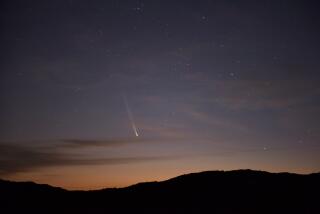NASA spacecraft around Mars send back images of comet Siding Spring
- Share via
NASA’s Mars Reconnaissance Orbiter has released the first resolved images of comet Siding Spring’s nucleus -- and it’s a lot smaller than people expected.
The nucleus of the comet that zoomed past the Red Planet on Sunday appears to be about half its predicted size of about half a mile. This surprising find could be one of many to come as scientists pore over the data sent back by the NASA orbiters and rovers that teamed up to study the mysterious visitor from the solar system’s distant Oort cloud.
All three orbiters -- the Mars Reconnaissance Orbiter, Mars Odyssey and Mars Atmosphere and Volatile EvolutioN, a.k.a. MAVEN -- captured data that are being relayed to NASA scientists. Both rovers, Curiosity and Opportunity, trained their “eyes” on the skies. The elderly Opportunity has already sent back images of the comet taken with its panoramic camera. It could take a few more days for all of the data to be downlinked and processed, the space agency said.
The teamwork should help researchers get a fuller picture of comet Siding Spring, which blazed by Mars on Sunday at 125,000 mph. At its closest approach about 11:27 a.m. Pacific time, the comet came within about 87,000 miles of Mars. That’s about one-third the distance between Earth and the moon.
After the comet formally known as C/2013 A1 Siding Spring was discovered in January 2013, scientists worried that it could damage NASA’s orbiters. After all, a high-speed speck of comet dust could potentially crack a camera lens or permanently damage delicate electronic systems. So NASA officials decided to steer all three craft into a safe zone on the other size of the planet until the worst of the danger had passed.
But scientists also recognized that a flyby like this was a once-in-several-million-years event. So they put the spacecraft to work.
The Mars Reconnaissance Orbiter trained three of its instruments -- the High Resolution Imaging Science Experiment, the Compact Imaging Spectrometer for Mars and the Context Camera -– on the comet as it approached the Red Planet. Their goal was to get a clearer picture of Siding Spring’s nucleus and to examine the coma of dust and gas that surrounds it. The three instruments will continue to watch the comet for a few more days as it continues its flight toward the sun. (It will make its closest approach on Saturday.)
Mars Odyssey is expected to provide some pictures as well, courtesy of its Thermal Emission Imaging System, or THEMIS. In a few days, THEMIS will produce an image that combines the comet with part of Mars, according to a statement from NASA’s Jet Propulsion Laboratory.
Chris Potts, manager of the Odyssey mission at JPL, confirmed Sunday that the spacecraft was able to carry out its scheduled observations “within hours of the comet’s closest approach to Mars.”
Both Odyssey and the Mars Reconnaissance Orbiter were also assigned to collect data on the interaction between the comet’s dust and gas and the planet’s thin atmosphere. In that task, they were joined by MAVEN, the most recent addition to NASA’s Mars fleet. MAVEN’s primary mission is to study the planet’s upper atmosphere, and it has a suite of instruments designed to examine the interface between the highest reaches of the Martian atmosphere and the beginning of outer space.
All three spacecraft emerged unscathed from their close encounter with Siding Spring, which is believed to have formed in the Oort cloud billions of years ago. If so, it is essentially a flying frozen time capsule from the solar system’s earliest days, formed of gas, water and dust not incorporated into Earth, Mars or the other planets.
Can’t get enough of Mars? Follow us at @aminawrite and @LATkarenkaplan for more science news from the Red Planet.








